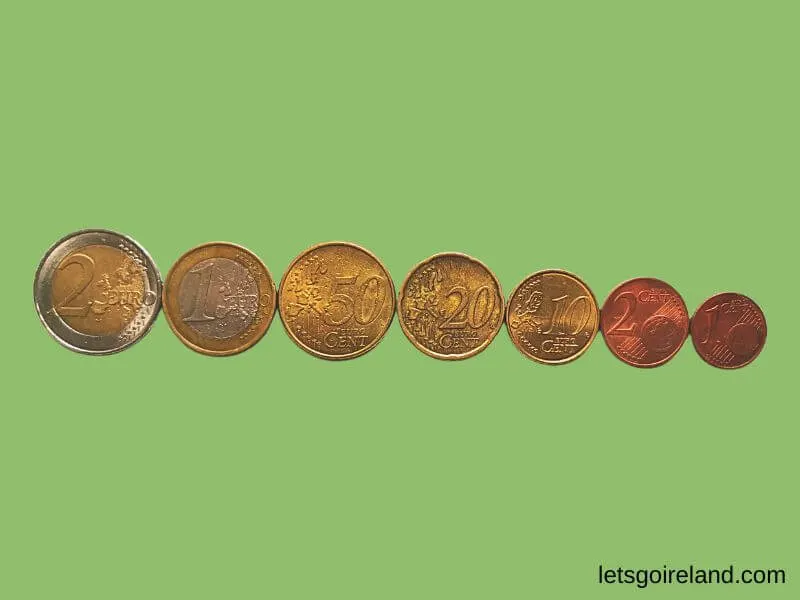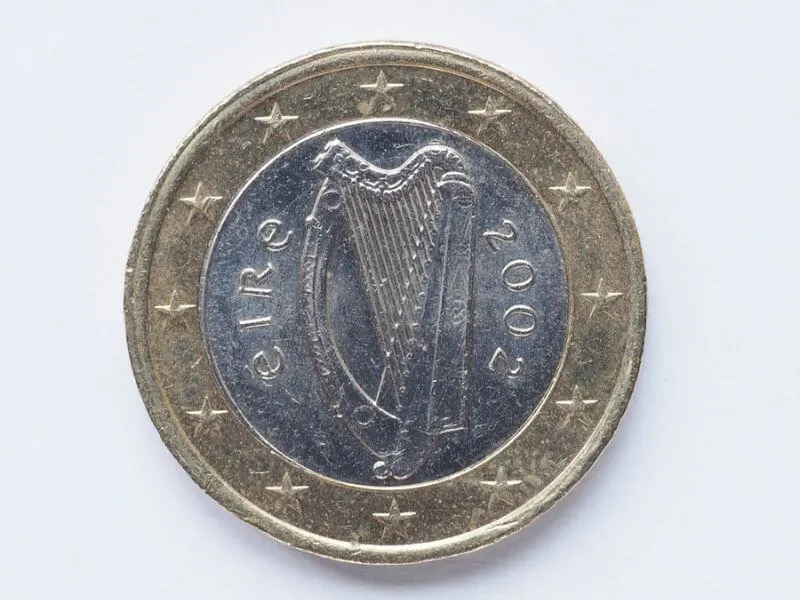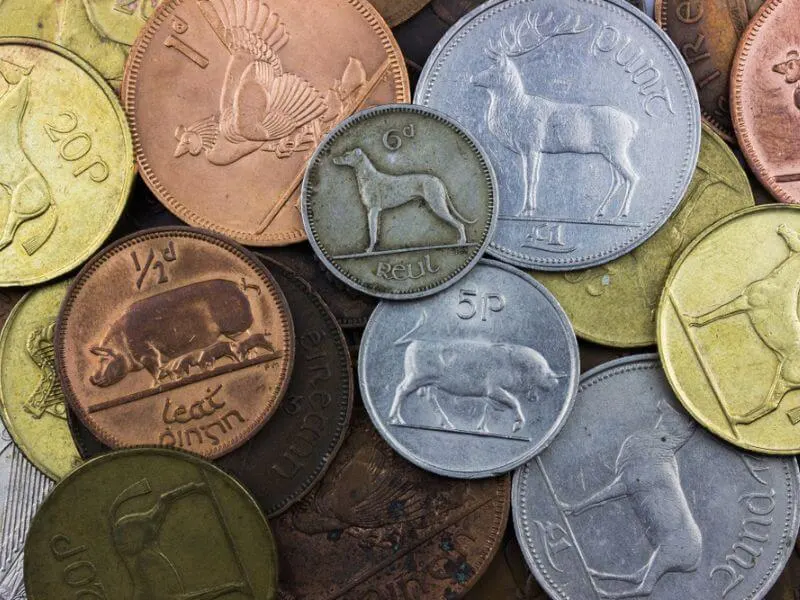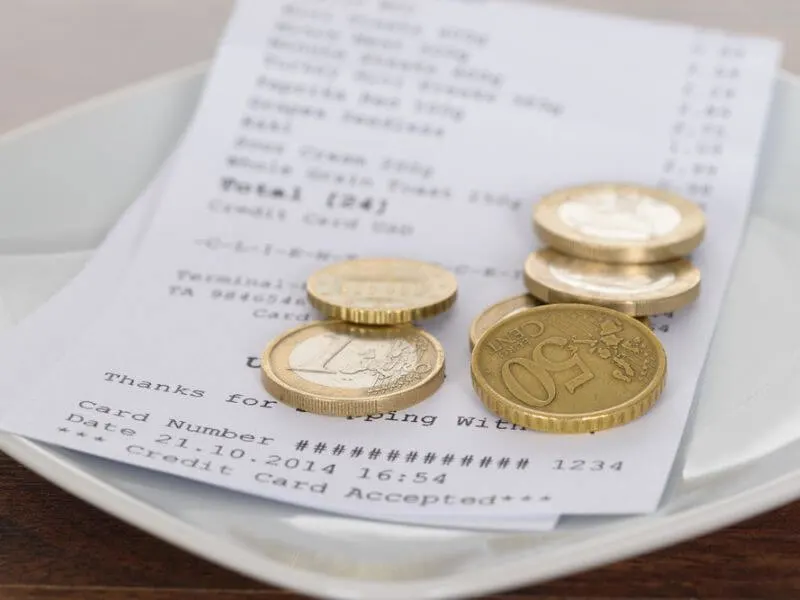One of the most important travel preparations is to learn about the currency of the country.
On a vacation trip, you do not want to experience a nasty surprise when you enter the country and find yourself without the local currency.
This article will tell you everything you need to know about the currency in Ireland, so you can have a really nice stay on the Emerald Isle without any worries.
This article may contain affiliate links. If you click on one of them, we might receive a small commission (at no extra cost to you). Thanks for your support to help us keep this site running!
Table of Contents
Currency in Ireland
Ireland is a divided island with two different currencies.
In the Republic of Ireland you pay with Euro. Before the introduction of the Euro, the Irish Pound was used in the Republic of Ireland.
In Northern Ireland, the currency is the British Pound.
What currency is used in Ireland?

The Republic of Ireland is a member of the European Union and uses the Euro currency.
This is the same currency as many other European countries, such as Germany, Austria, France, Spain and Italy.
Ireland Currency
The Emerald Isle joined the Eurozone on January 1, 1999 and was one of the first 12 countries to adopt the Euro on January 1, 2002.
Euro coins come in denominations of 2 Euro, 1 Euro, 50 cent, 20 cent, 10 cent, 5 cent, 2 cent and 1 cent.
On the reverse of Irish coins (minted by the Central Bank of Ireland) you will find the harp, which is also the Irish national symbol.
If you want to know the history of the symbol, click here.
In the case of Euro note denominations, these are available in the following denominations: €500, €200, €100, €50, €20, €10, and €5.
Tip: Usually, you will have no problems using the smaller bank note denominations. Notes over €50 in value may not be accepted in all shops, especially smaller ones.
Rounding of cash transactions
In an attempt to reduce the amount of 1 and 2 cent coins in circulation, many retailers now round the cost of a transaction up or down to the nearest 5 cent.
So don’t be surprised if the change you receive when paying in cash is slightly different to what you expect.
Did you know that it costs more to produce 1 and 2 euro cent coins than they are actually worth?

Irish Currency before the Euro
Until December 31, 2001, the official currency of Ireland was the Irish pound. This pound was divided into 100 pence.
Officially, the Irish Pound, or Irish Punt, was replaced by Euro on January 1, 1999, but the Euro only came into circulation on January 1 2002.
There was definitely an air of excitement on New Years Day 2002 when we could go to an ATM for the first time and withdraw Euro currency.
It took a few weeks for the Euro to be in full circulation, so it continued to be accepted as a means of payment until February 9, 2002.
I have plenty of memories of paying for items with the old Irish currency and receiving the change in Euro currency.
Fun Fact: After more than two decades, there are still Irish Pounds worth approximately 350 million Euros that have not been exchanged.
As in other countries, these may be exchanged at any time at the Central Bank of Ireland in Dublin.

Irish Currency Pre-decimalization
The Irish have been actively interested in moving away from the dependence of Great Britain in terms of currency since they sought independence.
When Ireland joined the European Monetary System in 1979, it broke with the parity with the pound sterling that had existed for nearly 150 years.
Prior to that, the Irish Pound was thus pegged to the value of the British pound.
Incidentally, before 1979, British bills were accepted in Ireland without any problems, but not the other way around.
Until the beginning of the 1970s, there was a pre-decimal division of the coins. This was also the case in Great Britain.
The pre-decimal coin denominations were as follows:
- one farthing (in Irish feoirling)
- half penny (leath phingin)
- penny (pingin)
- three pence (leath reul)
- sixpence (reul)
- shilling (scilling)
- florin (flóirín)
- half crown (leathchoróin)
What currency is used in Northern Ireland?
Northern Ireland is part of the United Kingdom (officially: United Kingdom of Great Britain and Northern Ireland).
The currency used in Northern Ireland is the British Pound or Pound Sterling.
Northern Ireland Currency
The official currency of Northern Ireland is Pound Sterling, but sometimes around the border area it is also possible to pay in Euro.
This is not always possible, so don’t count on it being possible in all cases.
If you are only passing through Northern Ireland for a short time, withdrawing Pound Sterling is usually not worth it.
On a road trip through the north of the island you can withdraw pounds with your credit card at many ATMs.
Note: A few banks in Northern Ireland legally print their own banknotes.
These often have a different design than the banknotes in e.g. England.
The value is the same. However, they are only used in Northern Ireland and are not accepted outside Northern Ireland.
So if you receive Northern Irish pounds, be sure to spend them before leaving.
Irish Currency Travel Tips
Good to Know before You Go to Ireland!
Before you travel to Ireland, make sure to inform your bank and credit and debit card companies of the trip to avoid any unwanted transaction complications.
You can also use this opportunity to ask about currency exchange rates, any other foreign transaction fees.
Perhaps it is also worth asking about any specific travel insurance they might recommend too in case you lose your card.
Do I need to bring cash to Ireland?
Having a little cash in Ireland might be useful, but don’t stock up too much before you go.
(Traveling with large amounts of cash is never a good idea.)
Some examples of times when cash might come in useful in Ireland are:
- In pubs, (especially rural areas) cash may be preferred at the counter.
- Some Bed and Breakfast accommodations may not also be able to accept cards. (This is less of an issue today, as in many cases the booking and payment is made in advance online.)
- Also, it is typical in Ireland to leave a tip on the table in the restaurant. (Sometimes it can be added directly to the bill, but not in all places.)
How much cash should I bring to Ireland?
Roughly about €100-€200 should be enough to get you started in Ireland once you land.
Rather than stock up on a lot of cash and bring it with you, the best option is probably to use cards and withdraw cash directly from ATMs in Ireland.
Bonus Tips:
- Airport ATMs may have higher fees than those located in cities.
- In order to exchange money in a bank in Ireland, you typically need to be a customer so this is not an option for most tourists.
FAQs about Ireland Currency

What is Ireland’s currency / Does Ireland have Euros or Pounds?
The Republic of Ireland has been paying in euros since January 1, 2002, while Northern Ireland uses the British Pound.
Why does Ireland have the euro?
Ireland joined the Eurozone on January 1, 1999 and was one of the first 12 countries to officially adopt the Euro as a means of payment on January 1, 2002.
Does Ireland use the same money as the UK?
No, Ireland has a different currency to the UK. The currency used in Ireland is the Euro, while the UK uses the Pound Sterling.
As Northern Ireland is part of the UK, the Pound Sterling is also used there.
Can I use US currency in Ireland?
No, US Dollars are not accepted as currency in Ireland.
The Euro is the currency of the Republic of Ireland and the British Pound is used in Northern Ireland.
It is easy to pay with a card in most places in Ireland, so you do not need to rely on cash.
How can I pay in Ireland?
In Ireland you can pay in Euro either in cash or with a card.
Contactless payment with cards is often possible in shops and restaurants up to amounts of €50.
You should make sure you know the 4-digit pin number for your card, as this will be necessary in some places.
Payment by card is also possible for smaller amounts (greater than €10) in most cases.
If you plan on using cash, then opt for some smaller bills, such as €50 and less as large bills (i.e. 100 Euro and up) are not very welcome in many stores.
Can I pay with dollars in Dublin? Can I pay with British Pounds in Dublin?
No, Dublin is the capital of the Republic of Ireland and Ireland is in the Eurozone.
Therefore, only Euro is accepted in Irish retail stores.
In Dublin, and generally in Ireland there are no possibilities (except in exchange offices) to pay officially with pounds.
Can I pay with Euro in Dublin?
Yes, the official currency in Dublin, the capital of Ireland, is the Euro.
What is the currency in Belfast?
Belfast is the capital of Northern Ireland.
Northern Ireland is part of the United Kingdom of Great Britain, where the official currency is the British Pound Sterling.
So in Belfast you pay with British Pounds.
By the way, the Scotland currency is also the British Pound because Scotland is part of the United Kingdom.
What is the currency in Ireland after Brexit?
The currency in the Republic of Ireland and Northern Ireland has not changed after Brexit.
Ireland is part of the EU and the Euro is legal tender.
Northern Ireland, still part of the United Kingdom of Great Britain, so the Pound Sterling is the official currency.
Can I use my credit cards or debit cards in Ireland?
In most cases, yes.
Debit cards and credit cards, such as Visa and Mastercard (Cirrus and Maestro), are widely accepted on the island of Ireland (i.e. both Republic of Ireland and Northern Ireland).
A small amount of cash is recommended, but you can mostly get by in Ireland without using cash. This is definitely the case in the larger cities.
ATMs are located in most major shopping streets and at most bank buildings in major cities and smaller villages.
Can I pay with American Express in Ireland?
American Express has lost its influence in recent years, but is still accepted in some places.
However, you should not rely on it.
What is a “hole in the wall”?
A “hole in the wall” is what an Automatic Teller Machine or ATM is commonly referred to as in Ireland.
This typically refers to the ATMs that are built into the side of a wall, for example outside banks.
Where can I find an ATM in Ireland?
Finding an ATM is unlikely to be a big challenge in the larger cities and towns.
As well as being found on the streets, there are often ATMs located inside convenience stores, supermarkets and petrol stations. These are typically privately owned.
One thing to note is these privately owned ATMs often have higher fees associated with them.
How much cash can you withdraw from an ATM in Ireland?
You can withdraw cash of up to about €700 per day from ATMs in Ireland. Some ATMs may have slightly lower limits.
Ask your bank before you go to Ireland if there is a daily limit on the amount that you can withdraw.
ATM Exchange Rate Fees
The fees for withdrawing money with a credit card can vary.
Irish bank ATMs don’t charge fees for withdrawing cash, but there may be foreign transaction fees from your home bank.
It makes sense to check with your bank beforehand about the conditions on the Emerald Isle.
Bonus Tip:
Always opt to complete the transaction in the local Euro local currency rather than your own home currency.
This is to avoid additional fee charges known as dynamic currency conversion (DCC).
Ireland Travel

Are you planning a trip to Ireland? Why not check out some of Ireland’s highlights for some itinerary inspiration.
We also have plenty of other great articles about what to visit in Dublin or other day trip ideas from around the country. Enjoy browsing!
